The world has evidenced a lot of changes in technology in recent years. Modern technology helps to complete any task in a few seconds smoothly. For example, you can now make any transactions safely because of a fantastic technology known as the blockchain.
If you are interested in baking, investing, cryptocurrency, Ethereum, and Bitcoin, you must know about the term blockchain. Blockchain development services provide a platform for investors to invest in various investing platforms.
What is Blockchain?
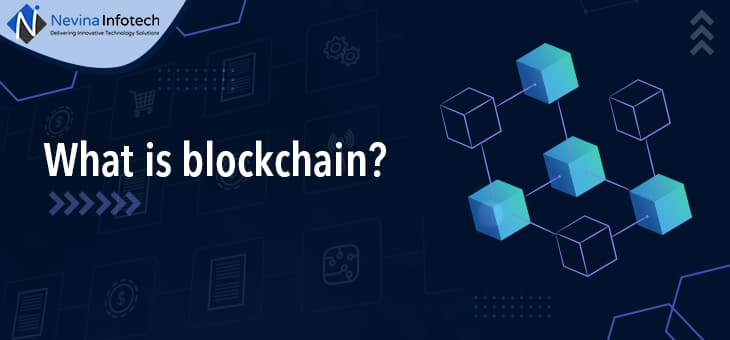
Blockchain might look complicated when you don’t know about it, but it is pretty smooth once you understand. Blockchain is a time-based series of immutable records of data maintained by many computers that an individual does not own. All the blocks of data are secured and combined with the help of a chain.
Moreover, every individual block will consist of information, and a chain-like structure will represent the process of linking. All the data saved inside the block is fully secured.
As blockchain technology evolves, a blockchain development company in India is also growing at a rocket speed.
What is Ethereum?
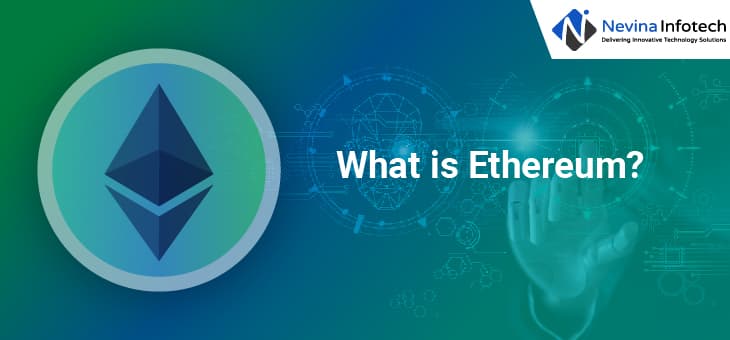
Mainly Ethereum is a blockchain platform with its cryptocurrency, which can be known as ether or Ethereum, and it has its programming language known as solidity.
Similar to the blockchain network, Ethereum development is a distributed public ledger to verify and record transactions. As a result, the network users can easily create, publish, monetize, and use applications on the platform and use its Ethereum cryptocurrency in payment.
Integration Challenges of Ethereum
Compatibility with Existing Systems:
Integrating the Ethereum blockchain into existing systems poses significant challenges. Many businesses and organizations operate on legacy systems that may not be designed to interact seamlessly with blockchain technology. The compatibility gap can lead to data silos, inefficiencies, and increased development efforts. Adapting existing databases and applications to work with Ethereum often requires custom solutions and thorough testing.
Legacy systems may use different data structures, security protocols, and databases, making integration complex. Transitioning from centralized systems to decentralized blockchain networks necessitates careful planning to ensure data consistency and reliability. Additionally, blockchain’s immutability can complicate data management. Whenever information is kept in touch with the Ethereum blockchain, it becomes super durable and can’t be adjusted, which can struggle with customary frameworks where information might be refreshed or erased.
What Are The Features of Ethereum Blockchain
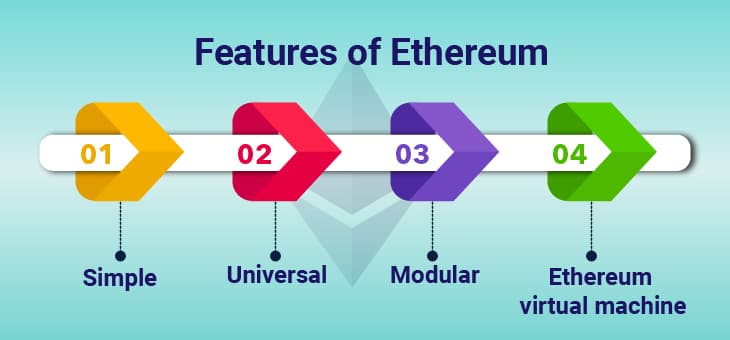
- Simple
- Universal
- Modular
- Ethereum virtual machine
Simple
The Ethereum app development blockchain formulas are made simple and easy to deploy, which saves the overall transaction cost. However, the low usage of Ethereum in its execution makes it famous among all developers, and users can cause most blockchains to occupy a lot of resources and energy to execute the transactions.
Universal
With the help of Ethereum development, developers can develop their smart contracts as per their perspectives. Ethereum blockchain will provide a wide range of space for the use of Blockchain technology.
If Ethereum app development is done correctly, it is possible to perform transactions secured and ready for implementation.
Modular
Ethereum contracts can be developed in small modules, which will combine to bring the desired functionalities. It makes for a scope of adjustment if required shortly. It is convenient to make a change to a modular rather than the whole protocol to make different changes.
Ethereum virtual machine
Ethereum virtual machine is created to handle runtime environments for compiling and implementing Ethereum-based smart contracts. It is a type of engine that will know the language of smart contracts written in the Ethereum programming language that is solid. Ethereum virtual machines are operated in an environment known as a sandbox. Therefore, you can test intelligent contracts and check their performance in the environment. If you are satisfied with the performance, you can implement it on the Ethereum main network.
Advantages of Blockchain Development for Ethereum
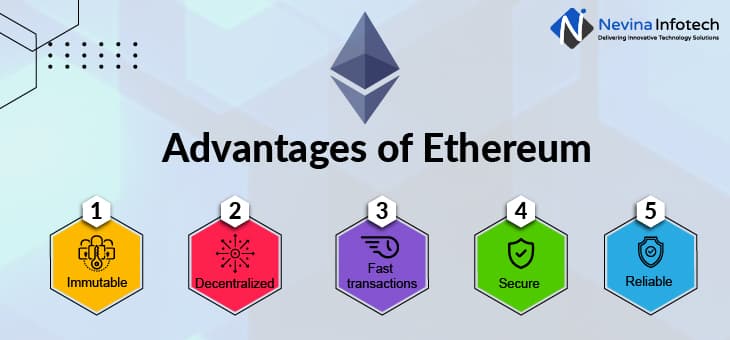
- Immutable
- Decentralized
- Fast transactions
- Secure
- Reliable
Immutable
One of the essential advantages of Blockchain development for Ethereum is that it will offer an entirely immutable platform. All transactions performed by the Ethereum blockchain are unchanged; it simply means the data you entered once cannot be ever changed. That makes it impossible to hack as even the person who has uploaded can’t edit or modify it once it is uploaded.
As the information is stored in a ledger, no one can later delete the information of the transaction.
Decentralized
It is the second most important platform of Ethereum development that is decentralized. The harmony mechanism needs to agree on the legality of the transaction; there is no need for a trustworthy mediator to perform various actions. The smart contract can be executed by itself.
Fast transactions
Instead of having lengthy manual verification and clearance, automation of Blockchain development service transactions assures that the process is relatively faster. It is also cheaper as it doesn’t have any need to pay third-party fees.
Secure
All transactions performed on the Ethereum platform are highly secured and have three times more security nodes than Bitcoin-verifying transactions.
Furthermore, Ethereum changes the pattern here. In reality, the network will use a cryptographic method that secures and encrypts all the data.
Reliable
It has proven itself to be a reliable platform, and its blockchain has been active for almost three years. As a result, applications built on the Ethereum platform will run similarly as programmed without any possibility of downtime, censorship, fraud, or third-party interference.
Disadvantages of Blockchain Development for Ethereum
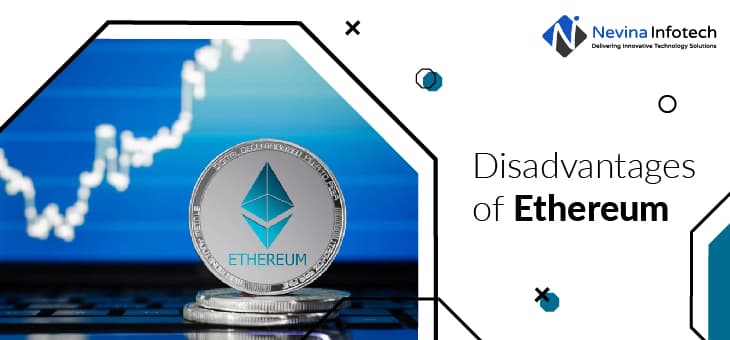
- Rising transaction costs
- Potential for crypto
- The harsh learning curve for developers
- Unknown future
Rising transaction costs
Its rapidly growing popularity has led to higher costs for transactions. Its transaction fees are also termed as “gas”. Which is excellent if you earn money but is less if you are trying to use the network. It happens because it is different from bitcoin, where the network itself will reward transaction verifiers whilst Ethereum requires that participating in the transaction cover the fee.
Potential for crypto
Ethereum has a yearly limitation of releasing 18 million ether annually, and there is nothing like a lifetime limit on the potential number of coins. It means that as an investment, it might function more similarly to dollars and will not be appreciated as much as Bitcoin, which has a compulsory lifetime limit on several coins.
The harsh learning curve for developers
Ethereum app development can be herculean for some developers to pick up as they will migrate from centralized processing to decentralized networks. In addition, Ethereum is hard to learn for developers as compared to other blockchain platforms.
Unknown future
Ethereum is frequently enhancing and getting better day by day, and the ongoing development of Ethereum 2.0 holds a promise of new functions and features and greater efficiency. However, the major update to the network is creating uncertainty for apps and dealing with those currently in use.
Energy Consumption:
The energy utilization related to Ethereum’s ongoing verification-of-work (PoW) agreement instrument has raised natural worriesPoW requires miners to solve complex mathematical puzzles, a process that demands significant computational power and electricity. This high energy consumption not only contributes to carbon emissions but also increases operational costs for miners. Ethereum’s transition to the PoS-based Ethereum 2.0 aims to address this issue by significantly reducing energy consumption, making it a more sustainable blockchain platform.
Network Congestion:
Ethereum often faces network congestion due to its popularity and limited scalability. When the network becomes congested, transaction fees can skyrocket, causing inconvenience for users. Delays in transaction processing can also occur, impacting the overall user experience. Layer 2 solutions, like Optimistic Rollups and zk-Rollups, aim to alleviate network congestion by processing some transactions off-chain and then settling them on the Ethereum mainnet, improving transaction speeds and reducing fees.
Risk of Fraud and Scams:
The decentralized and pseudonymous nature of Ethereum can create opportunities for fraudulent activities and scams. Malicious actors may create smart contracts or tokens with deceptive promises, leading to financial losses for unsuspecting users. Moreover, the irreversible nature of transactions on the blockchain can make it challenging to recover stolen funds. Users must exercise caution and due diligence when engaging in Ethereum-based transactions and verify the legitimacy of smart contracts and projects.
Slower Transaction Speeds:
Ethereum’s current transaction processing speed can be slower compared to traditional financial systems, particularly during periods of high network activity. This can lead to delays in confirming transactions, which may not be suitable for applications requiring near-instantaneous settlement. Layer 2 solutions and Ethereum 2.0’s scalability improvements are expected to mitigate this issue, offering faster and more efficient transaction processing, and making Ethereum a more attractive platform for a wider range of use cases.
Learning Curve for Developers:
Ethereum’s unique architecture and smart contract functionality require developers to acquire new skills and knowledge. The expectation to learn and adapt can be steep, especially for those new to blockchain development.
Developers must grasp blockchain concepts, cryptography, and Ethereum’s specific programming languages, such as Solidity. Ethereum development demands a deep understanding of decentralized applications (DApps) and smart contracts, which operate differently from traditional software.
Investigating and testing savvy contracts require particular apparatuses and approaches. Security is foremost in Ethereum advancement, and engineers should be knowledgeable in accepted procedures to keep away from weaknesses and assaults.
Learning how to design secure and efficient smart contracts adds to the learning challenge. To mitigate this challenge, many developers turn to online resources, courses, and communities to enhance their blockchain development skills.
How To Create A Cryptocurrency Exchange App Like Binance
What are the Use Cases of Ethereum
Financial Transactions:
Blockchain technology, particularly on the Ethereum network, has revolutionized financial transactions.It empowers secure, straightforward, and close momentary cross-line installments without the requirement for middle people. Smart contracts facilitate automated lending, borrowing, and investment processes, reducing the risk of fraud and errors. Decentralized finance (DeFi) platforms on Ethereum offer a wide range of financial services, including decentralized exchanges (DEXs), yield farming, and stablecoins, transforming the traditional financial landscape.
Supply Chain Management:
Ethereum’s blockchain has found extensive application in supply chain management. It enhances transparency and traceability by recording every step of a product’s journey on an immutable ledger. This helps in verifying the authenticity of goods, reducing fraud, and ensuring compliance with quality standards. Smart contracts automate contract execution, payment, and shipment tracking, reducing delays and disputes. Ethereum-based supply chain solutions have been adopted across industries, from food to pharmaceuticals.
How Much Does it Cost to Develop a Cryptocurrency Exchange App?
Healthcare:
In healthcare, Ethereum-based blockchain solutions enhance data security, interoperability, and patient privacy. Medical records can be securely stored and shared among authorized parties, improving the efficiency of healthcare delivery. Additionally, blockchain-based systems enable pharmaceutical supply chain tracking to prevent counterfeit drugs. Researchers also use Ethereum to create transparent and tamper-proof clinical trial records.
Voting Systems:
Ethereum-based voting systems provide a secure and transparent platform for elections and governance processes. It ensures the integrity of votes by recording them on an immutable ledger, making election results tamper-proof and easily auditable. Blockchain-based voting systems reduce the risk of fraud, enhance accessibility for remote voters, and increase overall trust in electoral processes.
Gaming:
Ethereum’s blockchain offers unique opportunities in the gaming industry. Non-fungible tokens (NFTs) on the Ethereum network have acquired fame, permitting gamers to claim, exchange, and sell in-game resources safely.
Decentralized applications (DApps) built on Ethereum enable player-driven economies, where gamers have more control over their virtual assets and identities. Ethereum-based blockchain games are also known for their play-to-earn models, allowing players to earn cryptocurrency through gameplay. This fusion of gaming and blockchain technology is shaping the future of the gaming industry.
How to Build NFT Marketplace? A Detailed Guide
Future Outlook in Ethereum
Potential for Evolution:
Transition to Ethereum 2.0: Ethereum is undergoing a significant transformation with the transition to Ethereum 2.0, also known as Eth2 or Serenity. This update plans to address a portion of the current limits, like versatility and energy utilization, by moving from a proof-of-work (PoW) to a proof-of-stake (PoS) agreement system.
Ethereum 2.0 introduces shard chains, enabling the network to process multiple transactions and smart contracts simultaneously. This transition promises improved efficiency, reduced energy consumption, and enhanced scalability, making Ethereum more sustainable and capable of handling a greater volume of transactions.
Emerging Technologies (e.g., Layer 2 Solutions):
To overcome the scalability challenges faced by Ethereum, various Layer 2 solutions are emerging. These include state channels, side chains, and Plasma chains. These technologies work alongside the Ethereum mainnet to offload some of the transaction processing, reducing congestion and fees. Layer 2 solutions aim to provide faster and more cost-effective transactions while maintaining the security and decentralization of the Ethereum network. As these innovations mature, they can possibly make Ethereum significantly more versatile and open for a more extensive scope of utilizations.
Government Policies:
The regulatory landscape for blockchain and cryptocurrencies, including Ethereum, is evolving rapidly. Governments and regulatory bodies are increasingly recognizing the need to establish clear policies to address issues related to taxation, fraud, and consumer protection. Some governments are embracing blockchain technology and are actively exploring the use of digital currencies. However, varying regulatory approaches across different countries can create challenges for international adoption and cross-border transactions. The future will likely see continued efforts by governments to strike a balance between innovation and regulation in the blockchain space.
Legal Frameworks:
Legal frameworks surrounding blockchain and Ethereum are still in the nascent stages. As blockchain innovation turns out to be more coordinated into standard businesses, there will be a developing requirement for extensive lawful structures to resolve issues like savvy contract enforceability, token guidelines, and information security.
Clarity in legal frameworks will provide a sense of security to businesses and investors, encouraging further adoption and innovation in the Ethereum ecosystem. Legitimate specialists and policymakers will assume a pivotal part in molding these structures to guarantee they line up with the innovation’s decentralized and worldwide nature while safeguarding the interests, everything being equal
Most of Applications For Ethereum
Here is the given below list of applications that can be based on Ethereum.
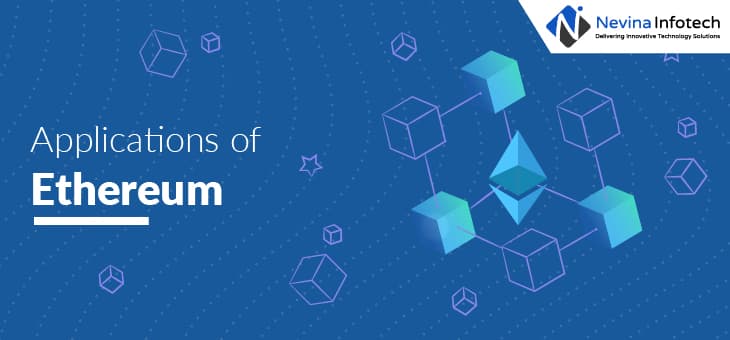
Wallets
As Ethereum can access intelligent contracts, its wallets are straightforward to customize your desired things and conditions. For example, it provides the facility of either holding the money in your wallet or creating a joint account where you can set limits for individuals.
Ethereum wallets are easy to deploy, and use, and provide malleability to the users to determine the laws of the wallet.
Cloud computing
The EVM can be used to develop a computing environment where various tasks of the project can be fulfilled remotely. However, here in cloud computing, it is not easy to verify the assignments completed by others.
It provides a verifiable system in which tasks can be readily accepted at the checkpoint to check if they were performed correctly or not as per the directions.
Escrow
With the help of Escrow, Ethereum has become the most trusted platform for performing various transactions. Likewise, in Bitcoin, the transactions are completed if one gains around 51% of the network’s computing power.
Dissimilar to Bitcoins, Ethereum will limit the transactions that can be easily done with the help of various nodes of the blockchain. Under the agreements of Escrow, no transactions can take place if the conditions are satisfied.
dApps
Decentralized applications are developed over the Ethereum blockchain. The applications work on end-to-end functionality other than a central server-based system, which eliminates the single point of error that is the server.
dApps are transparent and have trust in the users as users have accessed the information. In addition, a reduction of a central administrator makes it more reliable, as the data on the network is all the data stored on a server which the admin could later change if he wants.
Enterprise solution
The flexibility and security provided by the Ethereum blockchain development services network make Ethereum app development the best choice blockchain for the enterprise edition.
With the help of Ethereum’s smart contracts and the technologies, high interoperability makes it a great choice to integrate with the current system.
Why choose Nevina for Ethereum app development?
Nevina Infotech is one of the most preferred and leading Blockchain development companies in India. You can hire a blockchain developer, which offers seamless Ethereum app development for businesses that can be used all over the world.
With the help of our, dispersed application businesses can experience a safe and secure transaction and smooth operation to prevent their data from being hacked or fraud.
Reasons to choose our company:
- Integrity and transparency– Your app development idea is secured with us as we know the value of confidentiality and transparency. We also sign an agreement known as the Non-Disclosure agreement, which helps the client build trust in us.
- Skilled developers– We have a team of highly experienced and certified developers who are experienced and work with dedication for the client’s projects.
- Best results – Our developers are enthusiastic and are always ready to learn new skills and technologies that give the best app development results.
- Glitch-free projects– We are known to develop bug-free projects with 100% client satisfaction and according to their demand.
You can also get an estimated Cryptocurrency exchange app development cost to develop an Ethereum application.
Conclusion
Ethereum app development is growing at a vast pace, and blockchain is a platform that will provide a platform to Ethereum. However, as Ethereum is a new technology, it is efficient to bear some advantages and disadvantages. Our developers are dedicated to providing the best Ethereum app development services.
The main reason behind the success of every client project and their satisfaction is our developers are highly skilled and committed to their work.
Top 8 Digital Transformation Trends to Know About in 2024
FAQs
How does outsourcing for Ethereum software development work?
Our blockchain developers will get in touch with you, understand your project requirements, and help you develop the Ethereum app. We will offer you some project proposals from which you can choose. Choosing the Best Blockchain Developer and Solutions Partner for Your Website.
How much does it cost to develop an Ethereum app?
The cost of developing an Ethereum application varies depending on various factors such as features, developers, technological stack, and much more. Therefore, we cannot say the exact cost of developing an Ethereum application. Do professional Ethereum development services offer post-development support?
Do professional Ethereum development services offer post-development support?
Yes, we do offer post-development support and services. We are a well-known company that provides post-development services after deployment, not just for Blockchain development but also for every app development.
How long does it take to make the Ethereum app live?
Depending upon the scope of the project duration can be approximately between weeks or 2-to 3 months depending upon the project length. Therefore, we follow a smooth development process approach to deliver the project in the given time period without neglecting the app’s quality.
Can I avail myself of your services for cryptocurrency app development?
Yes, of course, as we are the leading Ethereum app development company, we offer design, development, and back-end support for a highly secure and scalable application. We can also provide you with the cryptocurrency exchange app development cost, which is approximate to give you a rough idea.



